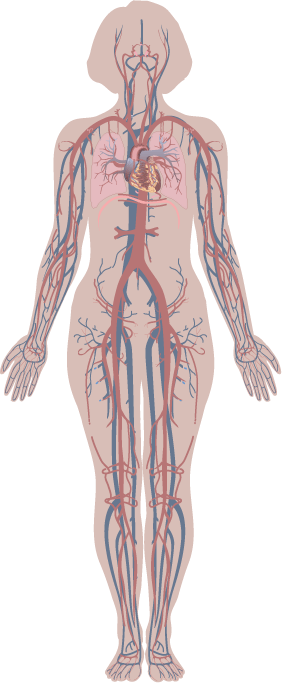Peripheral Vascular Disease, or PVD, is a general term that covers all diseases of the blood vessels outside the heart. PVD can affect both the arteries (that carry blood from the heart to the body) and veins (that carry blood from the body back to the heart).
The Peripheral Circulation
The circulatory system is made of blood vessels throughout your body that pick up oxygen from the lungs and distribute it to your muscles and organs. It is divided into two major parts: the pulmonary circulation and the systemic circulation.
- The pulmonary circulation is a loop of blood vessels that circles between your heart and lungs. The heart pumps blood to the lungs to pick up oxygen, and the oxygen-rich blood is returned to the heart to be distributed to the body.
- The systemic circulation supplies blood to all parts of your body except the lungs. The heart pumps oxygen-rich blood to your body through blood vessels called arteries. Once your organs and tissues use the oxygen, blood flows back to your heart through the veins. The heart pumps the oxygen-depleted blood back to the lungs and the cycle begins again.

The arteries (red) and veins (blue) that make up the peripheral circulation.
When the vessels that supply blood to your heart become narrowed or blocked by the buildup of fatty deposits (called atherosclerosis, or hardening of the arteries), blood flow to your heart is interrupted and the heart muscle does not get enough oxygen. This is the best-known form of heart and blood vessel disease, called coronary artery disease.
Just like the blood vessels of your heart, the vessels that supply blood to other parts of your body can become narrowed or blocked by atherosclerosis, or develop other problems that interfere with blood flow to parts of your body. Disease of arteries outside the heart is called peripheral artery disease (PAD). It causes different symptoms and problems depending on where the blockage is—a blockage in your brain can cause a stroke (damage to brain cells caused by lack of blood flow to parts of the brain), while a blockage in your legs causes leg pain and difficulty walking.
Click on any of the types of peripheral artery disease below to learn more:
- PAD in the Legs
- Carotid (Neck) Artery Disease
- Renal (Kidney) Artery Disease
- Aortic Disease
In addition to artery disease, the vessels that take blood back to your heart also can develop problems, known as Vein Disease. Blood clots can form in the large veins of the legs, causing pain and potentially fatal complications if the clot breaks off and travels to the lungs. The veins can also be gradually damaged over time and become unable to pump enough blood back to the heart.
Click below to learn more about vein disease:
- Deep Vein Thrombosis (blood clots in the deep veins of the limbs) and Pulmonary Embolism (blood clots that travel to the lungs)
- Chronic Vein Disease
Learn More about Peripheral Vascular Disease
- To learn how to recognize the signs and symptoms of PVD and what to do if you experience them, see Signs of PAD and Signs of Vein Disease
- Learn how you can lower your chances of developing PVD in Basics of Preventing PAD and Basics of Preventing DVT. You can also Find a PVD Screening Site near You.
- Find out what tests are used to diagnose PVD, and how well they work in women
Coming soon:
- Evaluate your treatment options
- If you’ve recently been diagnosed, check out Living with PAD and Living with Vein Disease for tips on preventing complications and improving your quality of life
- Check out our Links to Peripheral Vascular Resources for organizations that provide PVD information and education, and for links to support groups for women with PVD



